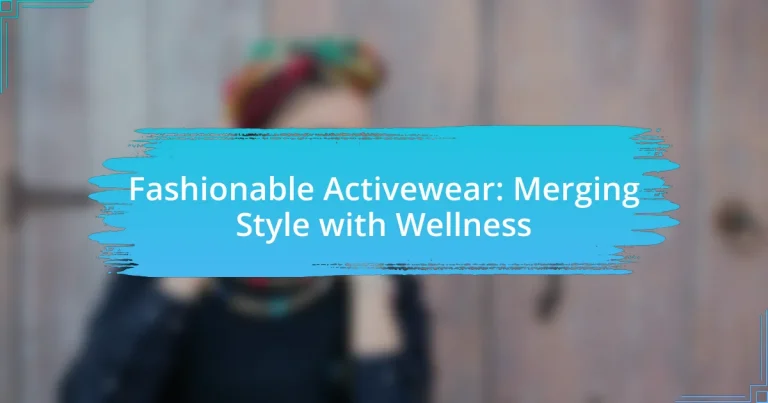Fashionable activewear refers to clothing designed for physical activity that prioritizes both functionality and style, incorporating elements like moisture-wicking fabrics and trendy designs. The evolution of activewear has transformed it from basic exercise clothing to a significant fashion category, influenced by historical movements and cultural shifts towards health and wellness. Key trends include the rise of athleisure, sustainable materials, and technological innovations that enhance performance. This article explores the defining characteristics of fashionable activewear, its impact on physical and psychological wellness, and practical tips for selecting and styling these garments for various occasions.

What is Fashionable Activewear?
Fashionable activewear is clothing designed for physical activity that also emphasizes style and aesthetics. This type of apparel combines functionality, such as moisture-wicking fabrics and ergonomic designs, with trendy elements like vibrant colors and modern cuts. The rise of athleisure, a trend where athletic clothing is worn in casual settings, has significantly contributed to the popularity of fashionable activewear, reflecting a cultural shift towards prioritizing both fitness and fashion in everyday life.
How has the concept of activewear evolved over time?
The concept of activewear has evolved from basic functional clothing for exercise to a multifaceted fashion category that emphasizes both performance and style. Initially, activewear consisted of simple garments like cotton t-shirts and sweatpants designed solely for physical activity. Over the decades, particularly from the 1980s onward, advancements in fabric technology introduced materials such as moisture-wicking synthetics and stretchable fabrics, enhancing comfort and performance.
By the 2000s, the rise of athleisure blurred the lines between gym wear and everyday fashion, leading to the incorporation of trendy designs and high-fashion elements into activewear collections. Brands like Lululemon and Nike began to focus on aesthetics alongside functionality, catering to consumers who desired stylish options for both workouts and casual outings. This shift is evidenced by the growing market size of activewear, which was valued at approximately $353 billion in 2020 and is projected to reach $547 billion by 2024, according to a report by Allied Market Research.
Thus, the evolution of activewear reflects a broader cultural shift towards health, wellness, and the integration of fitness into daily life, making it a staple in contemporary wardrobes.
What historical influences shaped modern activewear trends?
Modern activewear trends have been shaped by several historical influences, including the rise of physical fitness movements in the early 20th century, the feminist movement of the 1960s and 1970s, and advancements in textile technology. The early 1900s saw the emergence of organized sports and fitness, leading to the creation of specialized clothing for activities like tennis and swimming. The feminist movement advocated for women’s rights to participate in sports, resulting in the introduction of more functional and stylish options for women, such as leggings and sports bras. Additionally, innovations in synthetic fabrics, such as Lycra and moisture-wicking materials, have transformed activewear into performance-oriented apparel, enhancing comfort and functionality. These historical developments collectively inform the contemporary landscape of activewear, blending style with practicality.
How do cultural shifts impact the design of activewear?
Cultural shifts significantly impact the design of activewear by influencing consumer preferences, aesthetics, and functionality. For instance, the rise of athleisure as a fashion trend reflects a cultural movement towards casual, versatile clothing that can transition from workouts to everyday life. This shift has led brands to incorporate stylish designs, innovative materials, and multifunctional features into their activewear lines. Additionally, increased awareness of body positivity and inclusivity has prompted designers to create a wider range of sizes and styles that cater to diverse body types, as seen in brands like Aerie and Savage X Fenty. These changes demonstrate how cultural values shape the activewear market, driving brands to adapt their offerings to meet evolving consumer expectations.
What defines fashionable activewear?
Fashionable activewear is defined by its combination of functionality, style, and comfort, catering to both athletic performance and aesthetic appeal. This type of clothing often features moisture-wicking fabrics, ergonomic designs, and trendy patterns or colors that align with current fashion trends. For instance, brands like Lululemon and Nike have successfully integrated high-performance materials with stylish designs, making their products popular not only for workouts but also for casual wear. The rise of athleisure, which blends athletic and leisurewear, further emphasizes the importance of looking good while being active, reflecting a cultural shift towards valuing both fitness and fashion.
What materials are commonly used in fashionable activewear?
Common materials used in fashionable activewear include polyester, nylon, spandex, and cotton blends. Polyester is favored for its moisture-wicking properties and durability, making it ideal for high-intensity workouts. Nylon offers a smooth texture and is lightweight, providing comfort and flexibility. Spandex, known for its elasticity, allows for a full range of motion, which is essential in activewear. Cotton blends are also popular due to their breathability and softness, although they may not wick moisture as effectively as synthetic fibers. These materials are chosen for their performance characteristics, ensuring that activewear is both functional and stylish.
How do design elements contribute to the style of activewear?
Design elements significantly contribute to the style of activewear by influencing aesthetics, functionality, and user experience. For instance, the use of vibrant colors and unique patterns enhances visual appeal, making activewear more attractive to consumers. Additionally, design elements such as moisture-wicking fabrics and ergonomic cuts improve performance and comfort, which are essential for physical activities. Research indicates that 70% of consumers prioritize style alongside functionality when selecting activewear, highlighting the importance of design in consumer choices. Thus, effective design elements not only enhance the visual style of activewear but also align with the practical needs of users, reinforcing their overall appeal in the market.
Why is the merging of style and wellness important in activewear?
The merging of style and wellness in activewear is important because it enhances both physical performance and psychological well-being. Stylish activewear encourages individuals to engage in physical activities by boosting confidence and self-image, which can lead to increased motivation for exercise. Research indicates that wearing aesthetically pleasing clothing can positively influence mood and self-perception, thereby promoting a healthier lifestyle. For instance, a study published in the Journal of Experimental Social Psychology found that individuals who wore formal clothing performed better on cognitive tasks, suggesting that clothing can impact mental state and performance. Thus, the integration of style and wellness in activewear not only supports physical activity but also fosters a positive mindset, making it essential for overall health.
How does fashionable activewear promote physical wellness?
Fashionable activewear promotes physical wellness by enhancing motivation and encouraging regular exercise. When individuals wear stylish and comfortable activewear, they are more likely to engage in physical activities, as the clothing boosts their confidence and self-image. Studies indicate that individuals who feel good in their workout attire are more inclined to participate in fitness routines, leading to improved physical health outcomes. For example, a survey conducted by the American Council on Exercise found that 70% of respondents reported feeling more motivated to work out when wearing appealing activewear. This correlation between appearance and motivation underscores the role of fashionable activewear in promoting a more active lifestyle and, consequently, better physical wellness.
What psychological benefits are associated with wearing stylish activewear?
Wearing stylish activewear enhances self-esteem and motivation, contributing positively to psychological well-being. Research indicates that individuals who wear fashionable workout clothing often feel more confident and empowered, which can lead to increased physical activity. A study published in the Journal of Experimental Social Psychology found that clothing can influence psychological states, suggesting that stylish activewear can enhance mood and promote a more positive self-image. This effect is attributed to the concept of “enclothed cognition,” where the attire one wears affects their mental processes and behaviors.

What are the key trends in Fashionable Activewear?
Key trends in fashionable activewear include the rise of sustainable materials, the integration of technology, and the popularity of versatile designs suitable for both workouts and casual wear. Sustainable materials, such as recycled fabrics and organic cotton, are increasingly favored as consumers become more environmentally conscious. The integration of technology, including moisture-wicking fabrics and built-in fitness tracking, enhances performance and comfort. Additionally, versatile designs that transition seamlessly from gym to streetwear are gaining traction, reflecting a shift towards athleisure as a dominant fashion category. These trends are supported by market research indicating a growing demand for eco-friendly and multifunctional activewear, with the global activewear market projected to reach $546 billion by 2024.
How do sustainability practices influence activewear fashion?
Sustainability practices significantly influence activewear fashion by driving the adoption of eco-friendly materials and ethical production methods. Brands increasingly utilize recycled fabrics, such as polyester made from plastic bottles, which reduces waste and lowers carbon footprints. For instance, a report by the Global Fashion Agenda indicates that sustainable materials can reduce greenhouse gas emissions by up to 30% compared to conventional materials. Additionally, transparency in supply chains has become a priority, with consumers favoring brands that demonstrate ethical labor practices. This shift not only enhances brand loyalty but also aligns with the growing consumer demand for responsible fashion choices.
What sustainable materials are being used in activewear production?
Sustainable materials used in activewear production include recycled polyester, organic cotton, Tencel, and hemp. Recycled polyester, derived from post-consumer plastic bottles, reduces waste and energy consumption in manufacturing. Organic cotton is grown without synthetic pesticides or fertilizers, promoting environmental health. Tencel, made from sustainably sourced wood pulp, is biodegradable and produced in a closed-loop process that minimizes water usage. Hemp is a fast-growing plant that requires fewer resources and enriches the soil. These materials collectively contribute to reducing the environmental impact of activewear production.
How are brands promoting eco-friendly activewear lines?
Brands are promoting eco-friendly activewear lines through sustainable materials, transparent supply chains, and targeted marketing campaigns. Many companies utilize recycled fabrics, such as polyester made from plastic bottles, to reduce environmental impact. For instance, brands like Patagonia and Adidas have launched collections that emphasize the use of organic cotton and recycled materials, showcasing their commitment to sustainability. Additionally, brands often highlight their eco-friendly practices in marketing materials, emphasizing certifications like Global Organic Textile Standard (GOTS) and Fair Trade to build consumer trust. This approach not only appeals to environmentally conscious consumers but also aligns with the growing trend of sustainability in the fashion industry.
What role does technology play in fashionable activewear?
Technology plays a crucial role in fashionable activewear by enhancing performance, comfort, and style. Innovations such as moisture-wicking fabrics, breathable materials, and four-way stretch technology improve athletic performance while maintaining a fashionable appearance. For instance, brands like Nike and Under Armour utilize advanced textile engineering to create garments that regulate body temperature and provide support during physical activities. Additionally, the integration of wearable technology, such as fitness trackers and smart fabrics, allows consumers to monitor their health metrics seamlessly while wearing stylish activewear. This combination of functionality and aesthetics has led to a significant increase in consumer demand for activewear that not only performs well but also aligns with current fashion trends.
How are smart fabrics changing the landscape of activewear?
Smart fabrics are revolutionizing the landscape of activewear by integrating technology that enhances performance, comfort, and functionality. These fabrics can monitor physiological metrics such as heart rate, temperature, and hydration levels, providing real-time feedback to users. For instance, a study published in the journal “Textile Research Journal” highlights that smart textiles can improve athletic performance by allowing wearers to adjust their training based on biometric data. Additionally, smart fabrics often feature moisture-wicking properties and temperature regulation, which enhance comfort during physical activities. This technological advancement not only elevates the user experience but also drives innovation in the activewear market, leading to increased consumer demand for high-tech apparel.
What innovations are enhancing performance in stylish activewear?
Innovations enhancing performance in stylish activewear include moisture-wicking fabrics, seamless construction, and smart textiles. Moisture-wicking fabrics, such as polyester blends, effectively draw sweat away from the body, keeping athletes dry and comfortable during workouts. Seamless construction reduces chafing and enhances comfort, allowing for a greater range of motion. Smart textiles, embedded with sensors, monitor biometric data like heart rate and body temperature, providing real-time feedback to users. These advancements not only improve functionality but also maintain aesthetic appeal, aligning with the trend of merging style with wellness in activewear.
What styles are currently trending in fashionable activewear?
Currently trending styles in fashionable activewear include high-waisted leggings, oversized crop tops, and matching sets. High-waisted leggings provide both comfort and support, appealing to consumers who prioritize functionality while maintaining a stylish look. Oversized crop tops are popular for their relaxed fit, allowing for ease of movement during workouts. Matching sets, which often feature coordinated colors and patterns, have gained traction for their aesthetic appeal and convenience, making it easy for individuals to create a cohesive outfit. These trends reflect a growing emphasis on both performance and style in the activewear market, catering to the needs of modern consumers who seek versatility in their clothing choices.
Which colors and patterns are popular in the latest collections?
The latest collections in fashionable activewear prominently feature vibrant colors such as electric blue, neon green, and soft pastels, alongside patterns like geometric shapes and tie-dye. These choices reflect current trends that emphasize both energy and individuality in fitness apparel. For instance, a report by WGSN highlights that bold colors and dynamic patterns are increasingly favored by consumers seeking to express their personal style while engaging in wellness activities.
How do athleisure trends influence everyday fashion choices?
Athleisure trends significantly influence everyday fashion choices by promoting comfort and versatility in clothing. This shift has led consumers to prioritize functional yet stylish apparel that can transition seamlessly from workouts to casual outings. According to a report by Grand View Research, the global athleisure market was valued at approximately $155 billion in 2020 and is expected to grow, indicating a strong consumer preference for this style. As a result, traditional fashion brands have increasingly incorporated athleisure elements into their collections, reflecting a broader cultural acceptance of athletic wear as everyday attire.

How can consumers choose the right Fashionable Activewear?
Consumers can choose the right fashionable activewear by considering factors such as fit, fabric, functionality, and style. A proper fit ensures comfort and support during physical activities, while high-quality fabrics like moisture-wicking materials enhance performance by keeping the body dry. Functionality is crucial; consumers should look for features like pockets, breathability, and stretchability that cater to their specific activities. Additionally, selecting styles that align with personal aesthetics can boost confidence and motivation to exercise. Research indicates that 79% of consumers prioritize comfort and style when purchasing activewear, highlighting the importance of these factors in decision-making.
What factors should be considered when selecting activewear?
When selecting activewear, factors such as fabric type, fit, functionality, and style should be considered. The fabric type is crucial as materials like moisture-wicking polyester or spandex enhance comfort and performance during physical activities. The fit of the activewear must allow for a full range of motion without being restrictive, which is essential for effective workouts. Functionality includes features like pockets, breathability, and support, which can significantly impact the user experience. Lastly, style is important for personal expression and motivation, as aesthetically pleasing activewear can encourage regular exercise.
How does body type influence the choice of activewear styles?
Body type significantly influences the choice of activewear styles by determining the fit, support, and aesthetic appeal of the clothing. For instance, individuals with an athletic build may prefer fitted styles that highlight muscle definition, while those with curvier figures might opt for high-waisted leggings and supportive tops that provide coverage and comfort. Research indicates that 67% of consumers prioritize fit and comfort when selecting activewear, underscoring the importance of body type in these decisions. Additionally, brands often design specific lines catering to various body shapes, ensuring that activewear not only performs well during physical activities but also enhances the wearer’s confidence and style.
What is the importance of fit and comfort in activewear selection?
Fit and comfort are crucial in activewear selection because they directly impact performance and overall user experience. Proper fit ensures that the clothing allows for a full range of motion, which is essential during physical activities. Comfort, on the other hand, minimizes distractions and enhances focus, allowing individuals to engage fully in their workouts. Research indicates that discomfort can lead to decreased motivation and performance; for instance, a study published in the Journal of Sports Sciences found that athletes wearing poorly fitting gear experienced a significant decline in their performance levels. Therefore, selecting activewear that prioritizes fit and comfort is essential for maximizing both effectiveness and enjoyment in physical activities.
What are the best practices for caring for fashionable activewear?
The best practices for caring for fashionable activewear include washing in cold water, avoiding fabric softeners, air drying, and storing in a cool, dry place. Washing in cold water helps maintain the elasticity and color of the fabric, while avoiding fabric softeners prevents buildup that can affect moisture-wicking properties. Air drying is recommended to prevent shrinkage and damage from high heat, and proper storage helps maintain the shape and integrity of the garments. These practices are supported by textile care guidelines that emphasize the importance of temperature control and gentle handling to prolong the lifespan of activewear.
How can proper washing techniques extend the life of activewear?
Proper washing techniques can significantly extend the life of activewear by preventing damage to the fabric and maintaining its performance features. Washing activewear in cold water, using a gentle cycle, and avoiding fabric softeners help preserve elasticity and moisture-wicking properties. Additionally, air drying instead of using a dryer prevents heat damage, which can degrade synthetic fibers commonly used in activewear. Studies indicate that improper washing can lead to a 30% reduction in the lifespan of these garments, highlighting the importance of following recommended care instructions to ensure longevity.
What storage tips help maintain the quality of activewear garments?
To maintain the quality of activewear garments, store them in a cool, dry place away from direct sunlight. This prevents fabric degradation and color fading caused by UV exposure. Additionally, avoid folding activewear; instead, hang items or use storage bins to keep them organized and prevent creasing. Proper ventilation is essential, as moisture can lead to mildew, so ensure that storage areas are well-aired. Using garment bags for long-term storage can also protect against dust and damage. These practices are supported by textile care guidelines that emphasize the importance of environmental factors in preserving fabric integrity.
What are some tips for styling activewear for various occasions?
To style activewear for various occasions, consider pairing high-quality leggings with a tailored blazer for a chic look suitable for casual meetings. For outdoor events, opt for moisture-wicking fabrics and layer with a lightweight jacket to ensure comfort and style. When transitioning from the gym to brunch, a stylish crop top with joggers can be elevated with trendy sneakers and accessories. Additionally, incorporating versatile pieces like a stylish sports bra under a loose-fitting tank can create a fashionable yet functional outfit. These combinations allow for both practicality and style, making activewear adaptable to different settings.

















